What: The brief of this exercise was locate a subject which was a good distance away and using a combination of lenses and focal lengths, move from a wide angle view of the subject to a zoomed in tight view of the subject
Where: White Sands, East of Dunbar
When: Just after noon.
How: I decided to use a combination of lenses to photograph a lighthouse which was on the other side of the bay. I started at 11mm and moving through the range of this lens, I moved to an 18-55mm lens before finishing with a telephoto 70-300mm lens
f11 1/8 ISO 100 11mm (16mm at 35mm equivalent)
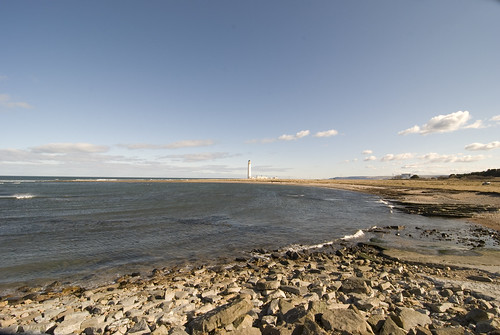
I decided to start by photographing as far away as I could, where I could have the lighthouse
in the centre of the frame as it touched the horizon.
I quite like this photo as the curve of the rocks in the foreground lead you off to the horizon where the lighthouse sits.
f11 1/80 ISO 100 14mm (21mm at 35mm equivalent)
 A slightly closer in photo. There is not much difference between the 11mm and the 14mm photo,
A slightly closer in photo. There is not much difference between the 11mm and the 14mm photo, however I feel that the 11mm image is better composed as it has more of a curve, showing the bay
and leading into the photograph.
f11 1/80 ISO 100 16mm (24mm at 35mm equivalent)
 Again lightly closer in , you can start to see the difference in the background of the photograph as
Again lightly closer in , you can start to see the difference in the background of the photograph asobjects disappear in the distance.
f11 1/125 ISO 100 18mm (27mm at 35mm equivalent)
 The lighthouse begins to stand out, more detail is shown and you can start to see the small buildings around the base of the lighthouse. The background on the right of the photo shows that the hills have almost disappeared out of the frame as the photographs zoom further into the lighthouse.
The lighthouse begins to stand out, more detail is shown and you can start to see the small buildings around the base of the lighthouse. The background on the right of the photo shows that the hills have almost disappeared out of the frame as the photographs zoom further into the lighthouse.
f11 1/125 ISO 100 18mm (27mm at 35mm equivalent)
 The lighthouse begins to stand out, more detail is shown and you can start to see the small buildings around the base of the lighthouse. The background on the right of the photo shows that the hills have almost disappeared out of the frame as the photographs zoom further into the lighthouse.
The lighthouse begins to stand out, more detail is shown and you can start to see the small buildings around the base of the lighthouse. The background on the right of the photo shows that the hills have almost disappeared out of the frame as the photographs zoom further into the lighthouse. f11 1/125 ISO 100 24mm (36mm at 35mm equivalent)
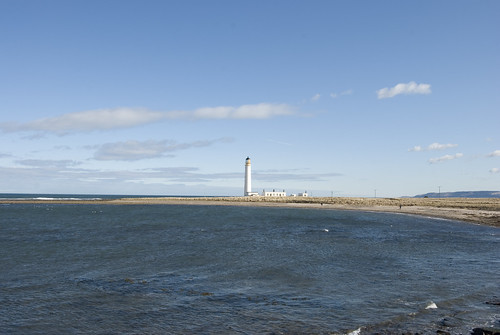 The lighthouse stands out now, I recomposed the photo slightly as there was a lot of negative space on the left of the photograph.
The lighthouse stands out now, I recomposed the photo slightly as there was a lot of negative space on the left of the photograph.
f11 1/160 ISO 100 35mm (52mm at 35mm equivalent)
f11 1/200 ISO 100 45mm (67mm at 35mm equivalent)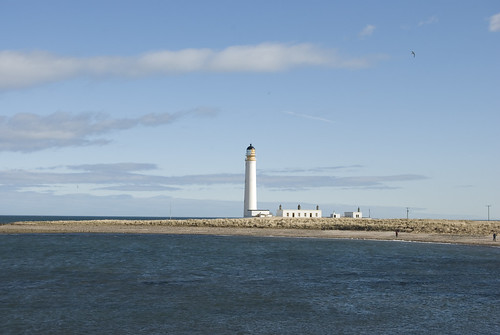 There is again not much difference in this photo and the one above. In this case all the background which was on the right hand side of the frame has now disappeared and the focus is becoming tighter on the lighthouse.
There is again not much difference in this photo and the one above. In this case all the background which was on the right hand side of the frame has now disappeared and the focus is becoming tighter on the lighthouse.
f11 1/200 ISO 100 55mm (82mm at 35mm equivalent)
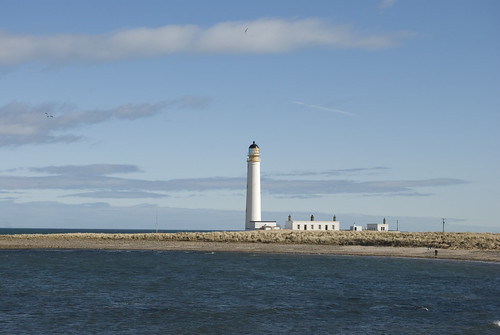 This photo starts to show the foreshortening of the subject as I am using a telephoto lens. the distance between the building in front of the lighthouse and the lighthouse itself have been flattened.
This photo starts to show the foreshortening of the subject as I am using a telephoto lens. the distance between the building in front of the lighthouse and the lighthouse itself have been flattened.
f11 1/160 ISO 100 70mm (105mm at 35mm equivalent)
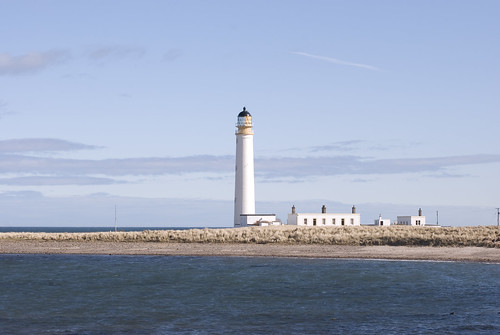 This is quite tight on the subject. At this point I should have moved the camera into portrait so that I could continue zooming into the lighthouse. However I wanted to capture not just the lighthouse but the buildings which huddled against it.
This is quite tight on the subject. At this point I should have moved the camera into portrait so that I could continue zooming into the lighthouse. However I wanted to capture not just the lighthouse but the buildings which huddled against it.
f11 1/200 ISO 100 86mm (129mm at 35mm equivalent)
 The top of the structure of the lighthouse is now clearly defined, as are the buildings below. Now not much of the bay is showing in the foreground.
The top of the structure of the lighthouse is now clearly defined, as are the buildings below. Now not much of the bay is showing in the foreground.
f11 1/200 ISO 100 135mm (202mm at 35mm equivalent)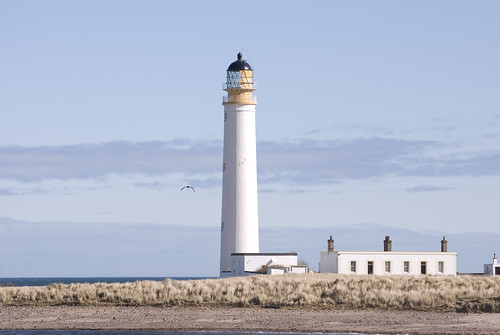 I decided to continue zooming into the lighthouse as part of the exercise so that I could later examine the wide angle photos are compare the amount of detail captured and so I could use a magnifying glass to examine the wide angle photo and compare it to this one.
I decided to continue zooming into the lighthouse as part of the exercise so that I could later examine the wide angle photos are compare the amount of detail captured and so I could use a magnifying glass to examine the wide angle photo and compare it to this one.
f 11 1/200 ISO 100 195mm (292mm at 35mm equivalent)
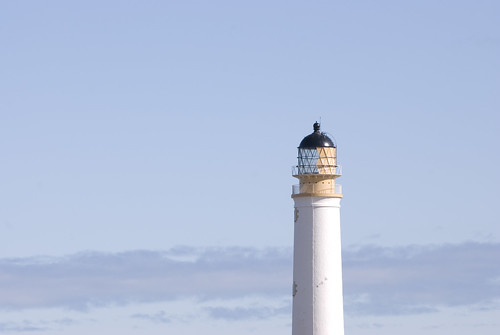 I decided to zoom into the top of the lighthouse to capture the structure of the glass at the top, to see if the frames around the panes of glass could be seen in the wider angle photos.
I decided to zoom into the top of the lighthouse to capture the structure of the glass at the top, to see if the frames around the panes of glass could be seen in the wider angle photos.
f11 1/160 ISO 1200 300mm (450mm at 35mm equivalent)
 The lighthouse stands out now, I recomposed the photo slightly as there was a lot of negative space on the left of the photograph.
The lighthouse stands out now, I recomposed the photo slightly as there was a lot of negative space on the left of the photograph.f11 1/160 ISO 100 35mm (52mm at 35mm equivalent)
The lighthouse is more distinctive now, the shapes at the top of the lighthouse are becoming more distinctive. The foreground is now the water of the bay.
f11 1/200 ISO 100 45mm (67mm at 35mm equivalent)
 There is again not much difference in this photo and the one above. In this case all the background which was on the right hand side of the frame has now disappeared and the focus is becoming tighter on the lighthouse.
There is again not much difference in this photo and the one above. In this case all the background which was on the right hand side of the frame has now disappeared and the focus is becoming tighter on the lighthouse.f11 1/200 ISO 100 55mm (82mm at 35mm equivalent)
 This photo starts to show the foreshortening of the subject as I am using a telephoto lens. the distance between the building in front of the lighthouse and the lighthouse itself have been flattened.
This photo starts to show the foreshortening of the subject as I am using a telephoto lens. the distance between the building in front of the lighthouse and the lighthouse itself have been flattened. f11 1/160 ISO 100 70mm (105mm at 35mm equivalent)
 This is quite tight on the subject. At this point I should have moved the camera into portrait so that I could continue zooming into the lighthouse. However I wanted to capture not just the lighthouse but the buildings which huddled against it.
This is quite tight on the subject. At this point I should have moved the camera into portrait so that I could continue zooming into the lighthouse. However I wanted to capture not just the lighthouse but the buildings which huddled against it.f11 1/200 ISO 100 86mm (129mm at 35mm equivalent)
 The top of the structure of the lighthouse is now clearly defined, as are the buildings below. Now not much of the bay is showing in the foreground.
The top of the structure of the lighthouse is now clearly defined, as are the buildings below. Now not much of the bay is showing in the foreground.f11 1/200 ISO 100 135mm (202mm at 35mm equivalent)
 I decided to continue zooming into the lighthouse as part of the exercise so that I could later examine the wide angle photos are compare the amount of detail captured and so I could use a magnifying glass to examine the wide angle photo and compare it to this one.
I decided to continue zooming into the lighthouse as part of the exercise so that I could later examine the wide angle photos are compare the amount of detail captured and so I could use a magnifying glass to examine the wide angle photo and compare it to this one.f 11 1/200 ISO 100 195mm (292mm at 35mm equivalent)
 I decided to zoom into the top of the lighthouse to capture the structure of the glass at the top, to see if the frames around the panes of glass could be seen in the wider angle photos.
I decided to zoom into the top of the lighthouse to capture the structure of the glass at the top, to see if the frames around the panes of glass could be seen in the wider angle photos.f11 1/160 ISO 1200 300mm (450mm at 35mm equivalent)
I enjoyed this exercise as it allowed me to compose over a number of focal lengths, looking back at the final images I can see where I could/should recompose the photos by either moving the camera to another location or changing the orientation of the camera.


No comments:
Post a Comment